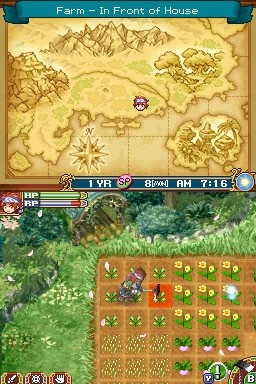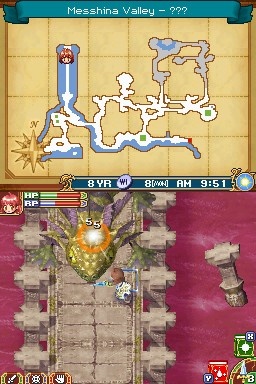Rune Factory 2: A Fantasy Harvest Moon is a role-playing game much like its predecessor, sharing a simplistic combat system that is traditionally lacking in Harvest Moon games as well as a unique social emphasis that operates as a dating simulator. Micromanagement is still the primary focus, with farming tasks and monster organization at the forefront, though exploration and a robust crafting system are also prominent. The game tests your patience, given that you're forced to work boring fetch quests around the in-game clock, not to mention the fact that the crafting system has to be unlocked. But those who don't mind waiting should find Rune Factory 2 a calming and pleasant adventure.
You're initially cast as Kyle, a traveler with amnesia who stumbles upon the small town of Alvarna several years after the events in the original. A young girl named Mana loans you a farm to keep you busy until you recover your memories. The game's most interesting aspect is that its plot spans two generations. Your control will eventually shift to Kyle's only child, at which point you'll progress the real story as additional gameplay features become available. Though the storyline is quite basic, it's more than sufficient to carry the sedate gameplay that follows.

The bulk of your time is spent managing the farm, which is surprisingly addictive and satisfying. You'll pull multicolored weeds, till the land, plant a variety of seeds depending on the season, water plants daily, and eventually harvest produce to sell at the local general store. Comfortable stylus controls and a convenient quick-select feature allow easier tool juggling and faster item access than in the original, though you can still rely on a simple button scheme if you prefer. Working, be it planting strawberries or watering flowers, drains your rune points, which serve as your stamina gauge. When your stamina reaches zero, your health begins to deplete, and when you run out of health points you'll collapse, which means a game over if you're in a dungeon. When you're not working the fields, you'll probably head for the nearest dungeon, where you tame vicious monsters by loving them into submission with gentle pats to the head. Those creatures that you collect can fight alongside you and are useful for working the farm while you're away, but it's disappointing that taming requires no skill; you simply pet monsters until they tire of pounding on you.
The game's social simulation element is similar to its predecessor's and affects monsters and people, adding an additional twist to both gameplay and plot. Grooming monsters increases their friendship level, which determines how productive they are in the fields, whereas daily chitchat with the locals raises their friendship and love gauges. You'll need to raise these levels if you wish to marry and progress to the second portion. The best way to do so is to complete jobs posted on the town's bulletin board. Unfortunately, the overwhelming majority of these tasks are effortless, mundane fetch quests restricted to delivering or retrieving items, and you can complete them only one at a time. To worsen matters, you'll have to complete quests around the in-game clock, which determines where people will be at certain times as well as when shops open and close. This means that you may find yourself wasting valuable time waiting on your fellow townspeople to show up or a store to open in order to finish a job, which could prove quite dull. You'll encounter the same annoyance as you spend days in bed to speed up the calendar so you can reach the next holiday, which finally advances the story by enabling you to court your desired spouse.
The elements that differentiate the Rune Factory games from the traditional Harvest Moon series--heavier exploration and combat--are relatively boring inclusions. There are only a handful of dungeons to explore, and the areas you can progress through are sharply limited until you reach the second portion, when dungeons finally expand and enemy variety increases beyond the simple addition of nocturnal monsters. Your chance of getting lost is quite rare due to the top screen's detailed map and the general lack of dungeon puzzles to master, which makes dungeon advancement straightforward but also unchallenging. The shallow combat system consists of mashing the attack button between dodging foes, though you can also blast opponents with basic spells or perform rune abilities, which are special attacks tied to specific weapon types. Most combat is mind-numbing and pointless, but fights are easily avoided unless you encounter minor slowdown, which is rare.
The crafting system, which is unlocked once you've reached the second generation, is robust enough to please item collectors and those looking for something to do while they wait on the in-game clock. You're able to cook a great variety of dishes, forge weapons, and craft helpful accessories by acquiring needed items through mining, logging, fishing, and farming. Before you start, you'll have to overcome a few hurdles, namely building the work areas and purchasing equipment, but combining items is a pain-free, fun process that should offset the relatively high cost of goods.

Alvarna consists of detailed prerendered environments dotted with colorful, cheery trees and town decor that changes according to the season. The 3D character models are cute if crude, using artistic character portraits for anime-style dialogue boxes during plot progression. Both sections of the game feature a full anime opening complete with theme song, and though they aren't of the highest quality, most should enjoy their aesthetic approach. Some exaggerated voice acting is included for special segments, but it occurs rarely enough that it's hardly a nuisance.
Replayability is high because you can spend countless hours farming, fishing, cooking, or forging the ultimate weaponry and accessories. Exploration and combat, if they suit your needs, will extend that amount significantly. Item collectors and monster lovers should enjoy trading via multicard multiplayer or the Nintendo Wi-Fi Connection, and those looking for a little challenge can play the sugoroku board game once its requirements have been met.
Though Rune Factory 2's shallow combat system and tedious fetch quests arguably make the game a little bland, most should be satisfied by its light, cozy adventuring and classic Harvest Moon gameplay.